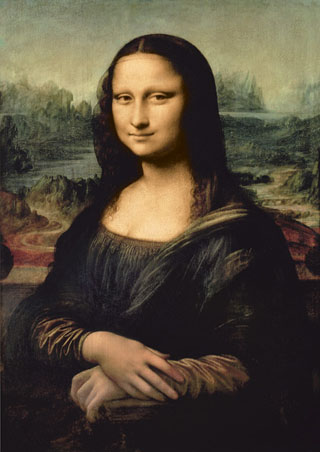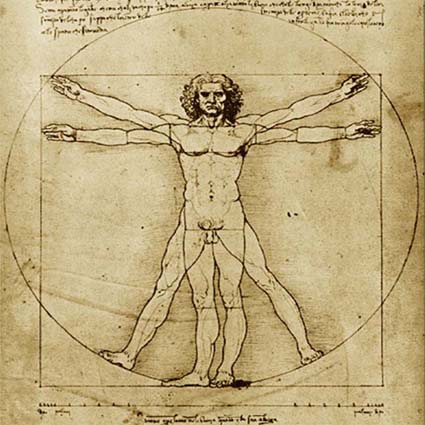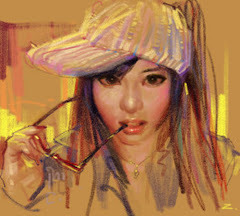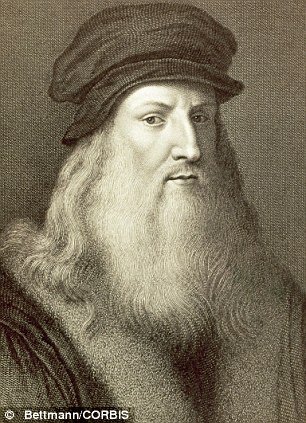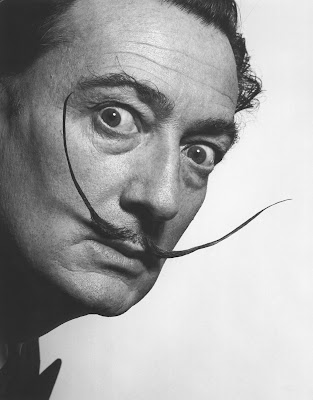
SALVADOR DALI
Salvador Dali, 1st Marquis of Púbol (May 11, 1904 – January 23, 1989), was a Spanish Catalan surrealist painter born in Figueres, Catalonia, Spain. Salvador Dalí was a skilled draftsman, best known for the striking and bizarre images in his surrealist work. Salvador Dali´s painterly skills are often attributed to the influence of Renaissance masters. Salvador Dali´s best known work, The Persistence of Memory, was completed in 1931.

The Persistence of Memory by Salvador Dali
La persistencia de la memoria (1931) or The Persistence of Memory is the most famous painting by artist Salvador Dalí. The painting has also been popularly known as "Soft Watches", "Droopy Watches", "The Persistence of Time", or "Melting Clocks".

Geopoliticus Child Watching the Birth of the New Man by Salvador Dali
In this painting Salvador Dali gives us a large egg-shaped globe of the world out of which a man is struggling to "hatch". This "new man" is coming out of North America - the United States. There is blood running out of the crack in the egg and the new man's hand has England firmly in its grasp. In the foreground two figures are watching; one an adult the other a small child. The adult, of indeterminate sex, is drawing the child's attention by pointing at the new man being birthed.

The Face of War by Salvador Dali (1940 - 41)
Salvador Dali is obsessed with death, wether it appears as the face of war or, more seductively, in the shape of female bodies. The props he designed for the film Moontide were so horrifying that they were rejected because the technician refused to build them.

The Elephants
Dali’s elephants are usually depicted with long, multi-jointed, almost invisible legs of desire, and carrying objects on their backs, which are also full of symbolism. These elephants represent the future and are also a symbol of strength. They are often shown carrying obelisks, which are symbols of power and domination, and not without phallic overtones. The weight supported by the animals spindly legs shows weightlessness, only made more significant by the burden on their backs.

Exploding Clock
The soft watch exploding adresses nuclear physics, einstenian physics and its relation to time. So in the exploding clock we can see time desintigrating, with einstein moving objects and the faster they move the slower they experience time. So Dali has moved that irrelevancy of time from the process of dreams to physics. Dali was an avid reader of the sciences and incluided many of its branches to his art from psychology, biology, chemistry and physics.

Temptation of Saint Anthony
In this picture temptation appears to Saint Anthony successively in the form of a horse in the foreground representing strength, sometimes also symbol of voluptuousness, and in the form of the elephant which follows it, carrying on its back the golden cup of lust in which a nude woman is standing precariously balanced on the fragile pedestal, a figure which emphasizes the erotic character of the composition. The other elephants are carrying buildings on their backs; the first of these is a obelisk inspired by that of Bernini in Rome, the second and third are burdened with Venetian edifices in the style of Palladio.
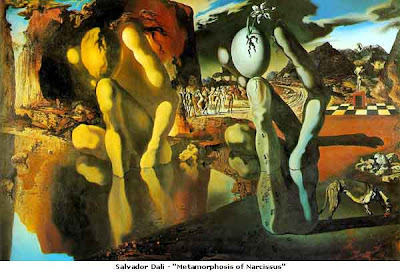
Metamorphosis of Narcissus
Metamorphosis of Narcissus (1937) is an oil-on-canvas painting by the Spanish surrealist Salvador Dalí. This painting is from Dalí's Paranoiac-critical period. According to Greek mythology, Narcissus fell in love with his own reflection in a pool. Unable to embrace the watery image, he pined away, and the gods immortalized him as a flower. Dali completed this painting in 1937 on his long awaited return to Paris after having had great success in the United States.

The Average Bureaucrat
The Average Bureaucrat is a loyal reproduction of the original artwork of the same title created by Salvador Dali in 1930. Akin to his contemporaries ‘The Surrealists’ Salvador Dali found Bureaucrats and indeed bureaucracy repugnant. Even so, it seems no coincidence that this composition was created in 1930 shortly after his father (Don Salvador) had disinherited and denounced him: And unquestionably, being a Notary his father could most certainly be regarded as a bureaucrat. Hence most critics feel this rather gross human being who seems to be asleep or dead upon the shores of the blackest sea is in fact a portrayal of the artist’s father.

Portrait of Laurence Olivier
The Olivier portrait was displayed next to Dali's fine portrait of Jack Warner of Warner Bros. Studios fame - a painting I saw many years ago at its home at Syracuse University, just a 3-hour drive east from my home in Buffalo. As it turns out, The Salvador Dali Society, Inc. (www.dali.com) recently acquired the fine study for Dali's portrait of Mrs. Jack Warner, the oil painting being, in my considered opinion, more impressive than the one of Jack himself.

Destino Animation
Destino is an animated short film released in 2003 by The Walt Disney Company. Destino is unique in that its production originally began in 1945, 58 years before its eventual completion. The project was a collaboration between American animator Walt Disney and Spanish painter Salvador Dalí, and features music written by Mexican songwriter Armando Dominguez and performed by Dora Luz. It was included in the Animation Show of Shows in 2003.

Spellbound Dream Sequence
Spellbound features is a famous dream sequence designed by Salvador Dali that includes some astonishing images, including huge floating eyes, twisted landscapes, and a faceless man in a tuxedo.

“Swans Reflecting Elephants”
“Swans Reflecting Elephants” (1937, private collection), is one of those magical Salvador Dali paintings that virtually everyone falls instantly in love with! It’s a stunning work by any meaasure: beautiful color scheme, super-fine draftsmanship, smooth, fluid tone to the composition – and simple but irresistible double-imagery.
Landscape Near Figueras
Landscape Near Figueras (1910) is a painting by the Spanish artist Salvador Dalí. This is one of the earliest known works by Dalí, having been painted when he was about six years old. At the beginning of Dalí's career, his primary influence was from the Impressionist movement. This painting is one of the purest examples of Dalí's impressionist period. Over the next ten years he would use increasingly brilliant colors and lighting until the 1920s, when he began creating cubist and Surrealist compositions.
Landscape with Butterflies
Beautifully colored and meticulously detailed, Salvador Dali’s “Landscape with Butterflies” exudes an unnerving ambiguity about its subjects’ scale, proportion, and proximity to other objects in the painting. Dali (1904 – 1989) a Surrealist master excelling in numerous styles and media, portrayed complex, symbolic dream imagery and familiar objects in startling forms. Pioneering the Paranoiac-Critical artistic style inspired by Freud, he accessed his subconscious for more intense artistic expression.

Slave Market with the Disappearing Bust of Voltaire
Slave Market with the Disappearing Bust of Voltaire (1940) is a painting by Spanish Surrealist Salvador Dalí. The painting depicts a slave market, while a woman at a booth watches some people. A variety of people seem to make up the face of Voltaire, while the face seems to be positioned on an object to form a bust. The painting was completed in 1940. Dalí describes his work on the painting "to make the abnormal look normal and the normal look abnormal."
The Station of Perpignan
Uncomfortable with the bureacracy at his local Spanish train station in Figueres, he chose to ship all his large canvases to the USA from Perpignan station. Dali also said he had a vision while inside the station, on 19 September 1963. He said “Suddenly, all appeared crystal-clear to me, I was in front of the centre of the world" The vision was followed his painting of Perpignan Station.
The Great Masturbator
The Great Masturbator is a self-portrait painted in July 1929. Dali's head has the shape of a rock formation near his home and is seen in this form in several paintings dating from 1929. The painting deals with Dali's fear and loathing of sex. He blamed his negative feelings toward sex as partly a result of reading his father's, extremely graphic book on venereal diseases as a young boy.
Illumined Pleasures
Illumined Pleasures was created by fusing oil and collage on panel. The canvas of the painting is small, measuring only 10" x 14" (24 x 34.5 cm); its size compared with the mass of detail Dali has managed to cram into it, clearly reveals Dali's great talent as a miniaturist painter.
The Invisible Man
The Invisible Man was not completed until 1932. It was the first painting in which Dali began to use the double images that were to flood his work over the next decade, during his "paranoia-critical" period. The double images used here are not as successful as the later painting, Swans Reflecting Elephants (1937). The viewer is aware of the illusions that Dali is creating before they are aware of what the overall form is meant to be.
Post Title
→SALVADOR DALI
Post URL
→https://popularpainters.blogspot.com/2011/10/salvador-dali.html
Visit Famous Painter for Daily Updated Wedding Dresses Collection
